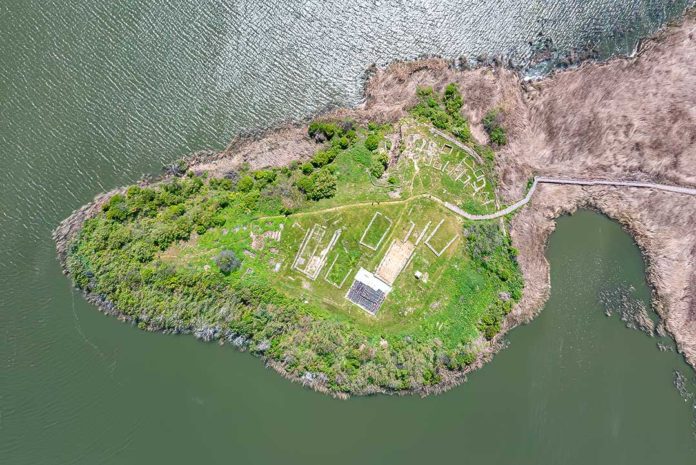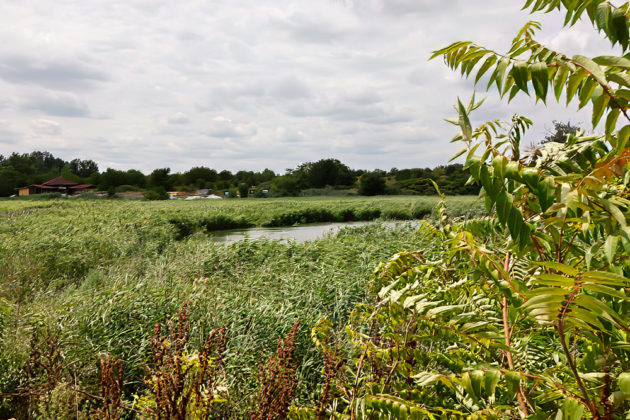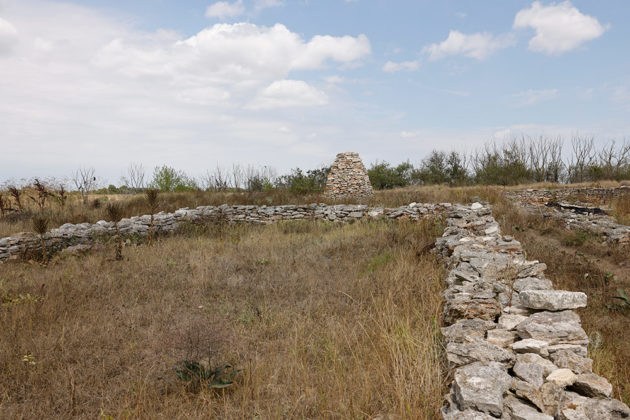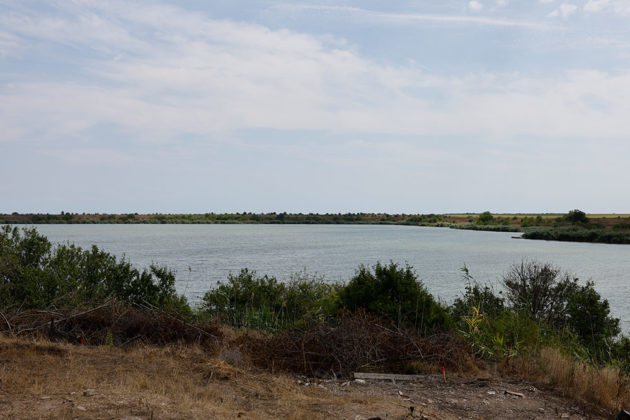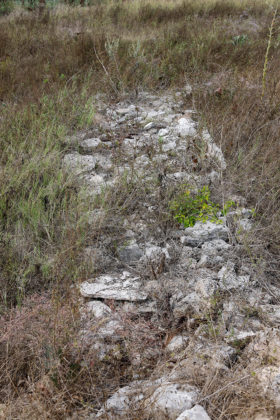Quick facts (at a glance)
- Where: NE Bulgaria, at the Durankulak Lake lagoon, ~15 km north of Shabla and ~6 km south of the Romanian border.
- Why it matters: One of Bulgaria’s most important wetlands (Ramsar Site No. 293) on the Via Pontica flyway and home to a multi‑layered prehistoric settlement & necropolis on the lake’s Big Island.
- Protection: National Protected Site (Order No. 123/21.02.1980; area 446.54 ha), Natura 2000 SCI BG0000154 “Ezero Durankulak” and SPA BG0002050 “Durankulashko ezero.”
- Signature wildlife: Winter flocks of the Red‑breasted Goose (Branta ruficollis) and *Greater White‑fronted Goose.
- Headline archaeology: The largest prehistoric cemetery in SE Europe (1,204 graves) and early stone architecture unique for its time in Europe.
Durankulak in two worlds: wetland & deep time
Stand on the dune‑backed beach and you’re eye‑level with a brackish liman—a coastal lagoon separated from the Black Sea by a narrow sand bar. The lake’s reedbeds, shallow bays, and karst springs make it a magnet for waterbirds moving along Via Pontica, Europe’s second‑largest migration highway. In winter, Durankulak and the nearby Shabla–Ezerets complex can hold a massive share of the world’s Red‑breasted Goose population; in some years, nearly the entire population concentrates here.
At the same time, the lake’s Big Island (Golemiyat ostrov) preserves a Neolithic–Chalcolithic settlement and a storied prehistoric necropolis, turning the shoreline into an open‑air archive of early European farming life.
A 7,000‑year timeline (the short version)
Neolithic / Hamangia culture (mid‑6th millennium BC).
People built rectilinear houses here, planned to a repeating layout and—remarkably—using stone architecture by c. 4700/4600 BC, an innovation considered unique in Europe at that time.
Chalcolithic / Varna culture (late 5th millennium BC).
Durankulak’s vast prehistoric cemetery—1,204 graves—belongs largely to this horizon and has yielded rich inventories (shells, copper, gold), crucial for understanding social structure in “Old Europe.”
Bronze Age / Early Iron Age.
Layers document later activity, including Coslogeni and Cernavodă cultural horizons.
Hellenistic period (late 4th–3rd century BC).
Cut into the island’s cliff is an excavated cave temple of Cybele (the Great Mother), with a rock‑cut well; the complex appears to have been active for roughly a century before rising waters forced abandonment.
Medieval (9th–11th centuries AD).
Settlement and burials continue the tale on the lake’s west shore—one of many proofs that Durankulak sits on a persistent, strategic route between the Danube and the sea.
The archaeological highlights (what you’ll actually see today)
- Big Island settlement mound – low stone wall bases mark multi‑room houses from the Early/Late Chalcolithic; drone and geophysical work continues to refine the plan of buildings and features.
- The prehistoric necropolis – not all of it is visible in situ (it extends under today’s lake), but the finds—including gold ornaments—are curated at the Regional Museum of History – Dobrich.
- Cybele’s cave temple – a cliff‑side sanctuary with a rock‑cut approach and well, dated mainly to 285–265 BC, now partially submerged seasonally.
Why archaeologists care: Durankulak is one of the most complete Neolithic–Chalcolithic sequences along the Western Black Sea, linking Hamangia roots to Varna heights (the culture behind the world’s oldest worked gold).
A living wetland: birds, reeds, dunes
Ramsar Site 293 “Durankulak Lake” protects a brackish‑to‑freshwater mosaic of open water, reedbeds (Phragmites, Typha), marsh fingers, and rare coastal dunes. More than 250 bird species occur annually; 92 nest. The site is significant for Red‑breasted Goose and Greater White‑fronted Goose wintering flocks.
The lake is also part of Natura 2000 as SCI BG0000154 and SPA BG0002050, reflecting its EU‑level significance for habitats and birds. Dune flora here hosts Balkan endemics and rare coastal plants (e.g., Ammophila dune habitats; Convolvulus persicus persists locally).
When to come for wildlife:
Dec–Feb for geese spectacles; Apr–May & Aug–Oct for migration diversity; Jun–Aug for botany and dragonflies. (Always keep distance from roosts and respect seasonal restrictions.)
Planning your visit
Where you’ll be: Durankulak village sits behind the dunes and beach that isolate the lagoon from the Black Sea; the archaeological complex is on the Big Island in the lake’s western arm.
Access & on‑site experience.
A visitor center and wooden boardwalks have been installed/under development to make the archaeological area easier and safer to visit; basic food/coffee options are nearby in season (locals will point you to Zlatnata Ribka / Golden Fish for that famed fish soup).
Best viewpoints for birds:
- The southern and western lake margins (from village roads) for dawn/dusk goose flights.
- The dune ridge behind the beach for panoramic wetland views—stay off fragile foredunes.
Responsible travel essentials:
- You’re in a strictly protected wetland under national and EU law—no off‑track driving, no drone disturbance near roosts/colonies, follow posted access.
- Winter roosts are sensitive: observe from a distance; avoid flushing birds (it costs them vital energy).
Nearby: easy add‑ons for a day or two
- Shabla Lighthouse & Cape Shabla. Bulgaria’s oldest and tallest lighthouse (32 m), now with Open Days in summer; the cape is the country’s easternmost point—a fine sunrise stop.
- Krapets & Ezerets beaches. Quiet, sandy stretches just south of the lake; low‑key stays for birders and families.
- Tyulenovo cliffs & rock arch. A dramatic shore of caves and a natural arch—beloved by divers and photographers. Exercise caution on the high ledges.
- Yailata National Archaeological Reserve. Cliff‑top cave dwellings, an Early Byzantine fort, and rock‑cut tombs overlooking the sea.
- Cape Kaliakra. A two‑kilometer headland with fortress remains, steppe flora, and frequent dolphin sightings on calm days,
Practicalities
- Seasonality: Archaeology is year‑round (weather permitting), but services peak June–Sept. Prime birding is winter—dress for wind.
- Getting there: The site lies off Bulgaria’s I‑9/E87 corridor; base in Shabla or Krapets for short hops to the lake and coast. (Local signage marks “Durankulak Lake / Дуранкулашко езеро.”)
- Museums: For context and artifacts (including gold pieces from the necropolis), visit the Regional Museum of History – Dobrich.
Deeper dive (for archaeology fans)
How big is the necropolis—and why is it famous?
Excavations have recorded 1,204 prehistoric graves spanning the Neolithic to the Copper Age, making Durankulak the largest prehistoric cemetery in Southeastern Europe. Analyses highlight status differences (grave goods skew male/elite in some phases) and long‑distance exchange (e.g., Spondylus shell).
“Oldest stone architecture” in Europe?
By the Late Neolithic/earliest Chalcolithic, stone architecture was already in general use here—houses with multiple rooms, rectilinear plans, and repeated layouts over generations—a phenomenon considered unique in Europe at the time.
A Hellenistic cave temple—then the sea rose.
A rock‑cut sanctuary of Cybele (the Great Mother) with a carved well operated roughly from the late 4th to the 3rd century BC. Geoarchaeology suggests that the late Hellenistic sea‑level rise flooded its floor; today, parts are accessible only in late summer/autumn water lows.
Suggested one‑day plan
Sunrise on the dune ridge → morning at the Big Island archaeological area (boardwalk circuit) → lunch in Durankulak/Krapets → afternoon run to Tyulenovo or Yailata → golden hour at Cape Kaliakra. (Swap in Shabla Lighthouse if its Open Day coincides.)
FAQ
Is Durankulak a beach, a lake, or a site?
All three: a beach‑backed lagoon (the lake), a village, and a multi‑period archaeological complex on the lake’s Big Island.
Can I visit the archaeological remains?
Yes—visitor pathways and a small center have been installed/are being finalized to help you explore safely. Check locally for seasonal hours or access updates.
What’s the best time to see the geese?
Mid‑winter (typically Jan–Feb) in calm, cold spells. Watch dawn lift‑offs and evening returns, keeping a significant buffer from roosts.


